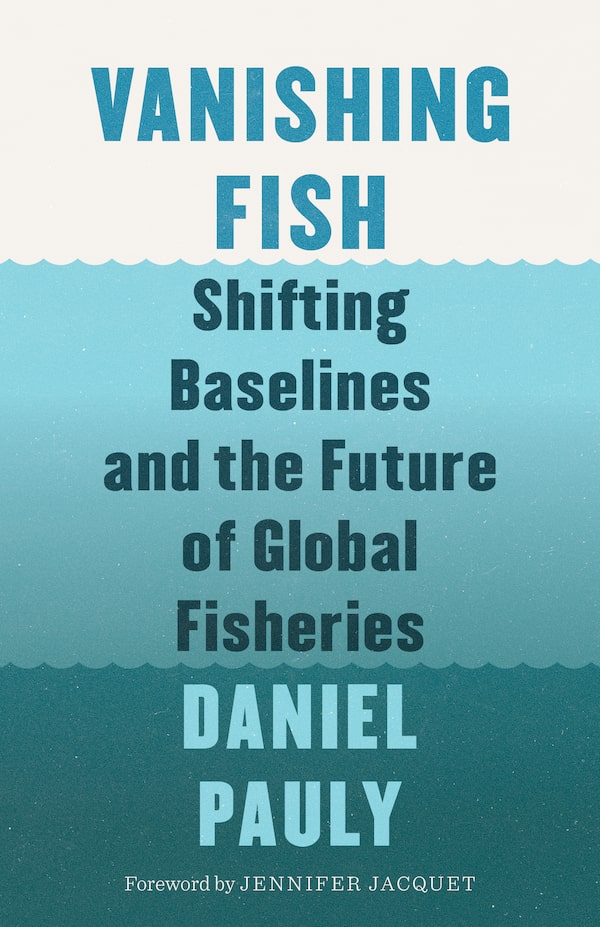
Supplied
- Title: Vanishing Fish: Shifting Baselines and the Future of Global Fisheries
- Author: Daniel Pauly
- Genre: Non-Fiction (Politics and Science)
- Publisher: Greystone Books
- Pages: 304
There was a time when there were so many fish in the seas that fishermen (for they were almost exclusively men) could land their daily catch so close to shore they could sleep in their own beds at night. That was long before the recent shockers that vertebrate animals have declined by 60 per cent on average since 1970 and another one million species are at risk of extinction due to human-inflicted wounds such as habitat loss and climate change. Fish are no exception. In his new book, Vanishing Fish: Shifting Baselines and the Future of Global Fisheries, Daniel Pauly demonstrates that the global biodiversity crisis is sinking life in the world’s oceans too.
A collection of essays written over the past two-plus decades, the book shows the deep-reaching consequences of out-of-control industrial fishing. “In the past 50 years,” the fisheries biologist writes, “we have reduced the populations of large commercial fish, such as bluefin tuna, Atlantic cod and other favourites, by a staggering 90 per cent.” Pauly, a researcher and professor at the University of British Columbia, is the founder and director of The Sea Around Us, which tracks the effects of overfishing on marine ecosystems. Like that project, Vanishing Fish gathers research (his and that of other scientists) and commentary, creating a reference where each essay zooms in on a specific issue (underreported catches, government subsidies, fish as commodity). Pieced together, they blast the warning that “with no change, there might be no ‘we.’” It’s not too late to fix the problem, if we understand a few major issues.
Lack of reliable data: Pauly writes “it is essential to know about catch, as the goal of a fishery is to generate and maintain a catch and, if possible, to increase it.” However, fleets often underreport catches; by-catches (fish caught unintentionally and discarded) rarely, if ever, factor into overall catch data; and illegal fishing volumes can, at best, only be guesstimated. Pauly hopes fisheries scientists will start using a global database created by The Sea Around Us, which expands on the United Nations’ Food and Agriculture Organization fisheries data by also mapping government subsidies, artisanal versus industrial fishing, tonnage of landed fish and more, from 1950. It has found that fishers now land fewer fish than their predecessors did.

Lacey Malarky, an Oceana campaign manager on illegal fishing and transparency, monitors the GPS position of a fishing boat in the Atlantic ocean from her computer at the headquarters of the NGO Oceana on June 10 in Washington.ERIC BARADAT
The “shifting baseline syndrome”: To restore fish stocks, we need to look at the past, comparing current fish populations with those before industrial-scale fishing began. It’s not enough for fisheries scientists, who often work for what Pauly refers to as the “fishing-industrial complex,” to say that stocks have doubled if they have merely increased from 1 per cent of past populations to 2 per cent. Because we keep adjusting our view of what is normal – a two-metre-long fish was normal 100 years ago, but the same fish now would probably measure no more than one metre; zero commercial cod fishing on the East Coast is normal today when it wasn’t a century ago – we’ve become comfortably numb in our collective environmental amnesia. Setting our baseline in the past helps us create a realistic picture of the health of current stocks.
Unsustainable fishing methods: In many jurisdictions, government subsidies keep more fleets fishing than the marine ecosystem can sustain. What’s more, Pauly argues that fisheries operate as a Ponzi scheme, where fleets go farther and farther to bring returns on investment to shareholders, leading to the rampant spread of overexploitation. Instead, Pauly suggests treating fish and the oceans as public resources or goods, and lease fishing licences to a smaller number of fishers to reduce catch sizes. Pauly also calls for the inclusion of “local communities living in real places and exploiting fish populations that have places as well” in order to create a sustainable future for fisheries.
A fisherman from the Boulogne sur Mer based trawler 'Nicolas Jeremy' stands next to the fishtank off the coast of Northern France, on Oct. 22, 2013.PASCAL ROSSIGNOL/Reuters
Protecting what we have: Before the fossil-fuel engine and trawlers, fishers were only able to skim the surface, keeping vast amounts of fish out of their reach. To safeguard and increase existing fish populations, stocks need to become inaccessible again. This can be done by creating marine protected areas and reserves where fishing is strictly limited or banned. These no-fish zones would give fish the space and time needed to reproduce, eventually restoring their numbers and diversity.
Pauly’s reflections on our own destruction of oceanic ecosystems add up to a dark and terrifying Marianas Trench. But protecting remaining marine resources is still within our reach – so long as we put pressure where pressure is needed. By demanding the implementation of conservation and fisheries-management strategies based on data sets that take into account what healthy seas looked like before industrial-scale harvesting, Pauly says it’s possible to have our fish and eat it too. A dive into Vanishing Fish is a chilling reality check. But it shows us how to push our heads above water.
Expand your mind and build your reading list with the Books newsletter. Sign up today.